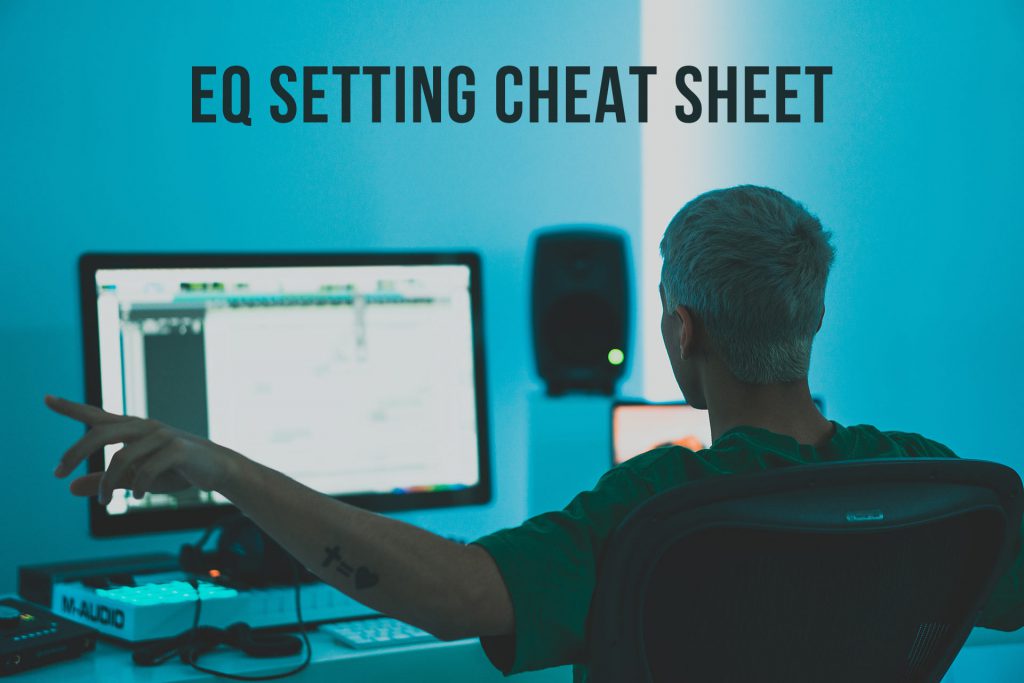In this article, you’ll learn the best EQ settings and frequency ranges for music production. You will learn how to EQ kick drums, samples and instruments to get your tracks sounding like the pros.
Want to know the best part?
Our reference guide is broken down by channel type – making it easier to learn which frequencies to focus on in your mix.
Let’s jump right into our ultimate ‘how-to’ guide for EQ.
Kick DrumS
Any apparent muddiness can be rolled off around 300Hz. Try a small boost around 5-7kHz to add some high end “snap” to your kicks that will translate well on smaller devices like mobile devices.
Frequency Effect
50-100Hz Adds bottom to the sound
100-250Hz Adds roundness
250-800Hz Muddiness Area
5-8kHz Adds high end prescence
8-12kHz Adds Hiss
Snares
Try a small boost around 60-120Hz if the sound is a little too wimpy. Try boosting around 6kHz for that ‘snappy’ sound.
Frequency Effect
100-250Hz Fills out the sound
6-8kHz Adds prescence
Hi hats, Cymbals, Rides
Any apparent muddiness can be rolled off around 300Hz. To add some brightness try a small boost around 3kHz.
Frequency Effect
250-800Hz Muddiness area
1-6kHz Adds presence
6-8kHz Adds clarity
8-12kHz Adds brightness
Bass
Try boosting around 60Hz to add more body. Any apparent muddiness can be rolled off around 300Hz. If more presence is needed, boost around 6kHz.
Frequency Effect
50-100Hz Adds bottom end
100-250Hz Adds roundness
250-800Hz Muddiness Area
800-1kHz Adds beef to small speakers
1-6kHz Adds presence
6-8kHz Adds high-end presence
8-12kHz Adds hiss
Vocals
This is a difficult one, as it depends on the mic used to record the vocal. However…Apply either cut or boost around 300hz, depending on the mic and song. Apply a very small boost around 6kHz to add some clarity.
Frequency Effect
100-250Hz Adds ‘up-frontness’
250-800Hz Muddiness area
1-6kHz Adds presence
6-8kHz Adds sibilance and clarity
8-12kHz Adds brightness
Piano
Any apparent muddiness can be rolled off around 300Hz. Apply a very small boost around 6kHz to add some clarity.
Frequency Effect
50-100Hz Adds bottom
100-250Hz Adds roundness
250-1kHz Muddiness area
1-6kHz Adds presence
6-8Khz Adds clarity
8-12kHz Adds hiss
Electric guitars
Again this depends on the mix and the recording. Apply either cut or boost around 300hz, depending on the song and sound. try boosting around 3kHz to add some edge to the sound, or cut to add some transparency. Try boosting around 6kHz to add presence. Try boosting around 10kHz to add brightness.
Frequency Effect
100-250Hz Adds body
250-800Hz Muddiness area
1-6Khz Cuts through the mix
6-8kHz Adds clarity
8=12kHz Adds hiss
Acoustic guitar
Any apparent muddiness can be rolled off between 100-300Hz. Apply small amounts of cut around 1-3kHz to push the image higher. Apply small amounts of boost around 5kHz to add some presence.
Frequency Effect
100-250Hz Adds body
6-8kHz Adds clarity
8-12kHz Adds brightness
Strings
These depend entirely on the mix and the sound used.
Frequency Effect
50-100Hz Adds bottom end
100-250Hz Adds body
250-800Hz Muddiness area
1-6hHz Sounds crunchy
6-8kHz Adds clarity
8-12kHz Adds brightness
Additional Notes to EQ string instruments:
Low End:
Anything less than 50Hz This range is often known as the sub bass and is most commonly taken up by the lowest part of the kick drum and bass guitar, although at these frequencies it’s almost impossible to determine any pitch.
Bass: 50-250Hz
This is the range you’re adjusting when applying the bass boost on most home stereos, although most bass signals in modern music tracks lie around the 90-200Hz area with a small boost in the upper ranges to add some presence or clarity.
Muddiness: 200-800Hz
The main culprit area for muddy sounding mixes, hence the term ‘irritational area’. Most frequencies around here can cause psycho-acoustic problems: if too many sounds in a mix are dominating this area, a track can quickly become annoying, resulting in a rush to finish mixing it as you get bored or irritated by the sound of it.
Mid-range: 800-6kHz
Human hearing is extremely sensitive at these frequencies, and even a minute boost around here will result in a huge change in the sound – almost the same as if you boosted around 10db at any other range. This is because our voices are centred in this area, so it’s the frequency range we hear more than any other. Most telephones work at 3kHz, because at this frequency speech is most intelligible. This frequency also covers TV stations, radio, and electric power tools. If you have to apply any boosting in this area, be very cautious, especially on vocals. We’re particularly sensitive to how the human voice sounds and its frequency coverage.
High Range: 6-8kHz
This is the range you adjust when applying the treble boost on your home stereo. This area is slightly boosted to make sounds artificially brighter (although this artificial boost is what we now call ‘lifelike’) when
mastering a track before burning it to CD.
Hi-High Range: 8-20kHz
This area is taken up by the higher frequencies of cymbals and hi-hats, but boosting around this range, particularly around 12kHz can make a recording sound more high quality than it actually is, and it’s a technique commonly used by the recording industry to fool people into thinking that certain CDs are more hi-fidelity than they’d otherwise sound. However, boosting in this area also requires a lot of care – it can easily pronounce any background hiss, and using too much will result in a mix becoming irritating.
You can also apply these EQ techniques on our loops and sample packs as well.


Pingback: EQ Technique: High Pass Filter To A Cleaner Mix
do u have any for dub-step
Help me please…. How should I adjust……. The frequency for edm….
Pingback: Vengeance Samples Used By Famous EDM Artists | Goldenchild Records